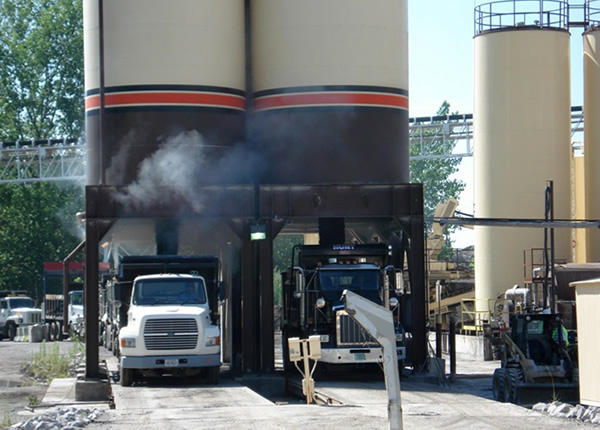Asphalt is the smooth, quiet, durable and sustainable surfacing material that has been around for hundreds of years. Today's asphalt is a scientifically designed product. It is rut, shoving and crack resistant. It is the most recycled material in the world.
Warm-Mix Asphalt
Warm-Mix Asphalt (WMA) has taken the U.S. Asphalt Industry by storm. Warm-Mix Asphalt by definition is Hot-Mix Asphalt (HMA) that is produced at temperatures 35° F – 100° F cooler than normal production HMA temperatures. This temperature reduction is done through the use of techniques that reduce the viscosity of the asphalt cement allowing coating of the aggregate at lower production temperatures. The benefits of this new technology are tremendous:
• Reduces burner fuel consumption
• Reduces volatile organic compound (VOC) emissions
• Easier compaction of asphalt pavement
• Increases use of RAP in mixes
• Better work environment
• Reduces or eliminates fumes and smells
• Eliminates premature “aging” of the asphalt cement
• Qualifies as LEED innovative technology points
World of Asphalt 2004 Demonstration (notice HMA loaded on the left and WMA on the right) Photo courtesy of NAPA
The History of Warm-Mix
Warm-Mix Asphalt was developed in Europe in response to EEC countries signing the 1997 Kyoto Treaty to reduce greenhouse gases. NAPA introduced WMA at the 2004 World of Asphalt show in Nashville, TN. NAPA projected that over 10 million tons of WMA will be placed in the U.S. in 2008.
WMA Technologies
Three main technologies are used in the production of WMA. The use of water to “foam” the asphalt cement, the use of organic additives and waxes, in the asphalt cement, and the use of chemical additives or surfactants in the Asphalt cement. These technologies all have advantages and disadvantages over their counterparts. To find further information of these different technologies click here.
The Benefits of Warm-Mix Asphalt
1.Reduces Plant Fuel Consumption – Studies have shown that running your plant at 35° F – 100° F lower will reduce fuel consumption by an average of 15%.
2.Reduces VOC Stack Emissions – The EPA has found that volatile organic compounds (VOC) released through the stack of an asphalt plant are well within required EPA guidelines. The use of WMA has been shown to reduce these emissions between 50-90%.
3.Easy to Compact. WMA has been found to be easier to compact, especially very stiff mix designs. Some contractors have eliminated a roller from the paving train. This saves money, time and energy resources.
4.Increased RAP Usage – The reduced viscosity of the WMA allows for easier coverage of the RAP and because the asphalt cement is not being aged at higher temperatures, the virgin asphalt binder may help to rejuvenate the inherent binder of the RAP. The increased use of RAP is a savings to contractors, agencies, and creates sustainable pavements by reducing the need for petroleum and virgin aggregates.
5.Fume and Smell Reduction – The largest source of emissions from an asphalt plant is the result of fuel combustion during the drying and heating process. The decrease in fuel consumption is directly correlated to reducing these emissions. In addition, reducing temperature at load out and paving has a direct correlation to fumes at the plant and asphalt pavers.
6.Better Work Environment – The reduction in temperature behind the paver makes a more comfortable environment for employees and government workers.
7.Reduces “Aging” Asphalt Cement – The heating of asphalt cement oxidizes the material for every 25° F it is heated.2 By decreasing the temperature needed to produce WMA we may be decreasing the “aging” of the asphalt binder and thereby creating longer lasting pavements.
For more information on Warm Mix Asphalt click here.
Warm Mix Asphalt
Click here to add text.






